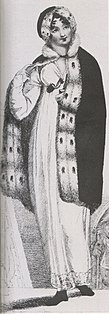Witgchouras
"Fashionable Witzschoura" a "rich with Fehfell " occupied coat
Witgchouras was the name of a women's coat lined with fur , which was current around the beginning of the 19th century.
Opposite are two very different women's outerwear, both of which are known as “witzschoura” in English, from the first decade of the 19th century. The lady on the left wears a sleeveless cape that comes down over her hips, is lined with ermine fur or imitation ermine and is broadly trimmed, with a matching cap, the lady on the right has an equally lush coat. The spelling “Witz-choura” (1814) can also be found on French fashion prints.
Marcel Sexé describes the Witgchouras than one with Sealskin be fed shell fashion brought by the French Suvaroff. The sealskin is the bear seal's coat , from which the stiff upper hair has been removed so that only the soft undercoat remains. At that time the fur was always dyed black.
Paul Lacroix writes about the garment: “In 1809 the Parisian women no longer remembered that they used to stand up against the winter frost in their light robes, now they wrapped themselves in furs, which they named“ Witgchouras «They put on fur hats that covered half their face and seemed to freeze even in summer».
The word comes from Polish, where it means wilczura ( wilˈt̯ʈ͡ʂura ), derived from "wilk" (pl., Wolf). Other sources derive Witgchouras or Witzschoura as coming from Russian, denoting a fur coat.
Web links
Individual evidence
- ^ Elisabeth Ewing: Fur in Dress . BT Batsford Ltd., London 1981, pp. 93 + 94. ISBN 0-7134-1741-2 .
- ^ Incroyables et Merveilleuses . 1814, Merveilleuse, No. 20 Toque de Velours - joke choura de satin .
- ↑ Marcel Sexé: Two Centuries of Fur Trading 1723-1923 . Romance of the Revillon Family . Printed by Draeger Frères, Paris December 1923, p. 13. (English).
- ↑ Paul Lacroix: Directorium, Consulat und Kaiserreich 1795-1815 , p. 96. Last accessed on July 27, 2017.
- ↑ Bruno Schier , primary source Karl Friedrich Kretschmann, Complete Works . Leipzig 1784–1799, VI, p. 165.
- ↑ www.lexikus.de Max von Boehn: The mode - people and fashion in the nineteenth century. 1790 to 1817 . Last accessed April 11, 2012.

